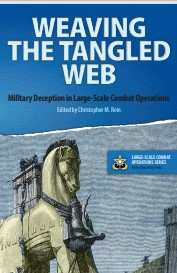
|
Weaving the tangled web : military deception in large-scale combat operations
-- Tangled web :
Copies
0 Total copies, 0 Copies are in,
0 Copies are out.
Title
Weaving the tangled web : military deception in large-scale combat operations -- Tangled web :
Call No
U167.5.D37
Digital Link
Subjects
Deception (Military science)--History--20th century.
Deception (Military science)--History--Case studies.
Combat sustainability (Military science)--History--20th century.
Combat sustainability (Military science)--History--Case studies.
World War, 1914-1918--Deception.
World War, 1939-1945--Deception.
Korean War, 1950-1953--Deception.
Israel-Arab War, 1973--Deception.
Falkland Islands War, 1982--Deception.
Persian Gulf War, 1991--Deception.
Operation Bagration, 1944.
Operation Mincemeat.
Operation Fortitude.
Operation Overlord.
El Alamein, Battle of, Egypt, 1942.
Saint-Mihiel, Battle of, Saint-Mihiel, France, 1918.
Megiddo, Battle of, Israel, 1918.
World War, 1914-1918--Campaigns--Palestine.
World War, 1914-1918--Campaigns--Israel.
World War, 1914-1918--Campaigns--Mediterranean Sea.
Stalingrad, Battle of, Volgograd, Russia, 1942-1943.
World War, 1939-1945--Campaigns--Russia (Federation).
World War, 1939-1945--Campaigns--France--Normandy.
Jassy, Battle of, Romania, 1944.
World War, 1939-1945--Campaigns--Romania.
Maskirovka.
Combat sustainability (Military science)
Deception (Military science)
Large-scale combat operations
LSCO.
Case studies.
History.
Deception (Military science)--History--Case studies.
Combat sustainability (Military science)--History--20th century.
Combat sustainability (Military science)--History--Case studies.
World War, 1914-1918--Deception.
World War, 1939-1945--Deception.
Korean War, 1950-1953--Deception.
Israel-Arab War, 1973--Deception.
Falkland Islands War, 1982--Deception.
Persian Gulf War, 1991--Deception.
Operation Bagration, 1944.
Operation Mincemeat.
Operation Fortitude.
Operation Overlord.
El Alamein, Battle of, Egypt, 1942.
Saint-Mihiel, Battle of, Saint-Mihiel, France, 1918.
Megiddo, Battle of, Israel, 1918.
World War, 1914-1918--Campaigns--Palestine.
World War, 1914-1918--Campaigns--Israel.
World War, 1914-1918--Campaigns--Mediterranean Sea.
Stalingrad, Battle of, Volgograd, Russia, 1942-1943.
World War, 1939-1945--Campaigns--Russia (Federation).
World War, 1939-1945--Campaigns--France--Normandy.
Jassy, Battle of, Romania, 1944.
World War, 1939-1945--Campaigns--Romania.
Maskirovka.
Combat sustainability (Military science)
Deception (Military science)
Large-scale combat operations
LSCO.
Case studies.
History.
Language
English
Published
Fort Leavenworth, Kansas : Army University Press, 2018.
Publication Desc
xi, 238 pages : illustrations, map ;
ISBN
9781940804415
LCCN
2018033519
Series
Target Audience
General
Dimensions
23 cm.









